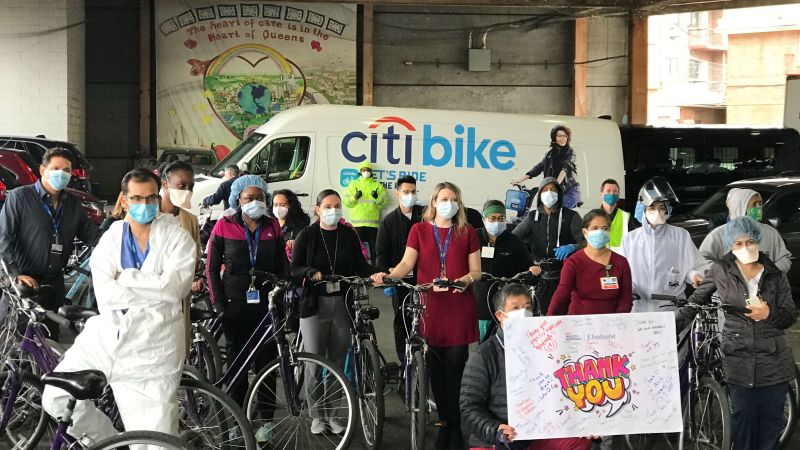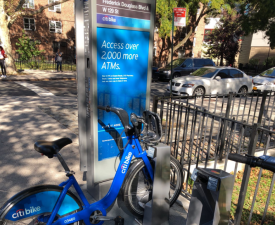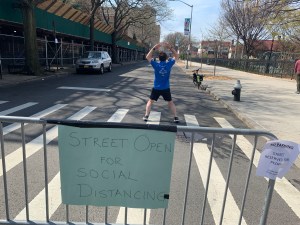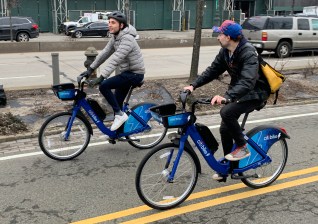Hospital Workers Outside Citi Bike’s Reach Will Get Bikes, But What About Bike Lanes?
With private help, the city assembles a small fleet — but offers no new protected lanes — for hard-hit staff.

Workers at Elmhurst Hospital in Queens — the first and hardest hardest hit in the coronavirus crisis — received a small fleet of 30 bicycles that they can use at no cost — but they aren’t getting a Citi Bike dock, despite Mayor de Blasio’s recent promise that they and other hard-hit hospitals would be getting such facilities soon.
Elmhurst and several other hospitals in coronavirus hotspots, such as Saint Barnabas and Jacobi in the Bronx, are outside of Citi Bike’s service area — leaving them without access to a vital form of transportation that during the pandemic. The clamor for expanding bike share for essential workers has been so great that, last Wednesday, the Mayor’s Office tweeted, “If a hospital needs a new @citibikenyc dock, they’ll get one! Whatever our tireless workers need to keep saving lives and get to work.” But that proved to be an empty promise.
The 30 bikes, which arrived to workers Monday morning, are part of a 100-bike fleet donated by bike-rental company Bikes Unlimited to a pilot program of the New York City Economic Development Corporation, the Department of Transportation, and Lyft, which operates Citi Bike.
The city declined to name which other hospitals would share the remaining 70 bicycles or say when workers at those hospitals might get them. A spokesperson said that more information would be disclosed “in the coming days and weeks” and that the choice of facilities would be guided by “capacity and demand” from staff at various hospitals, as would any expansion of the program beyond the initial 100 bikes. Lyft transported the bikes to Elmhurst and will be using its van fleet to bring bikes to other hospitals.
This morning, we partnered with @NYC_DOT, @CitiBikeNYC & @lyft to deliver more than 30 bikes from @bikerentnyc to Elmhurst Hospital, providing @NYCHealthSystem staff with a vital transportation option during the COVID crisis. pic.twitter.com/Rp31h1eTFI
— NYCEDC (@NYCEDC) April 20, 2020
A source familiar with the program said that relying on donated bikes from the private sector was an easier and faster solution for the hospitals than installing Citi Bike docks next to them, which would create “islands of service” miles away from the next-nearest dock — a difficult lift for Lyft.
Neither would the city commit to installing any protected bike lanes in order to help ensure the safety of essential workers using bicycles for commuting. A look at the city’s own bike map shows that there’s no direct route to Elmhurst Hospital via a protected bike lane; the streets leading to the hospital only have painted lanes. Only two of the city’s seven other public hospitals outside of Citi Bike’s current coverage area, Coney Island and Jacobi, are located next to protected bike lanes, in the form of greenways on Ocean Parkway and Pelham Parkway, respectively.
“As we expand bike access to our healthcare workers to make it easier for them to commute while social distancing, the city needs to provide more bike lanes and improve the bike lines that currently exist,” said State Sen. Jessica Ramos, who represents the area. “Improving our bike infrastructure now will benefit New Yorkers long after this crisis is over.”
For all that, the pilot bike-share program represents a rare instance of the de Blasio administration’s using bicycles to ameliorate transportation problems during the crisis. Last month, the mayor doled out more parking placards to healthcare workers. Even as cycling has burgeoned as people avoid transit during the pandemic, the city has installed only two temporary bike lanes (one on Smith Street and one on the Second Avenue gap in Manhattan), and responded to the need for budget cuts by proposing to delay desperately needed (and cheap) protected bike lanes and bus-priority measures. The mayor’s lack of priority to opening public space for people and neglect of bike-safety infrastructure has so exasperated some healthcare workers that this week a bike-riding physician’s assistant at Bellevue begged Hizonner for a safe route across the Queensboro Bridge.



